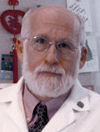Meld intuition with deliberation to sidestep diagnostic trap
Would you pass “the eyeball test” if the patient in this case study presented in your hospital's emergency room? Find out how one physician pressed for a better answer on a patient who presented with cardiac pain but no evidence of a heart attack.

Cognitive science posits two systems of thought, the intuitive and the deliberative. Intuition occurs rapidly, largely beneath the surface of conscious thought. Deliberation occurs more slowly and is consciously analytical. Both kinds of thinking are critical in medicine.

Lynn Bentson, FACP, of the Albany Internal Medicine Group in Albany, Ore., submitted a case that illustrates the importance of combining these two modes of thought. The patient was a 32-year-old man who presented to the ER around 4 a.m. on a Saturday, complaining of chest pain. He had a family history of early coronary artery disease and was a cigarette smoker. He was diaphoretic, but denied dyspnea or nausea. “The ER doctor said he just looked bad,” Dr. Bentson recalled.
Intuition: the eyeball test
Donald Redelmeier, MD, of the University of Toronto, used the term “the eyeball test” to describe a physician's intuitive response to a patient. A seasoned clinician develops a sense just by looking at a patient, before any focused physical examination or laboratory testing, that there is a serious underlying problem (from “How Doctors Think,” p. 22).
In the emergency room, Dr. Bentson's patient's vital signs were normal and he was afebrile. The physical examination by the ER physician did not reveal any abnormal findings. The chest X-ray was clear and EKG showed no ST elevations. Laboratory testing showed a normal CBC, electrolytes, glucose and troponin I of less than 0.01. A therapeutic trial of antacids in the ER did not alleviate the patient's symptoms.

Because the patient's initial complaint was chest pain, the ER physician anchored on a cardiac origin for the problem despite a normal EKG and undetectable troponin. He contacted a cardiologist at a neighboring hospital who recommended a CT angiogram. Although this test was negative, the ER physician remained anchored on a cardiac diagnosis. Because the patient “looked bad,” he admitted him for presumed “unstable coronary syndrome.”
“Finally, the ER doctor calls the cranky hospitalist on-call (me),” Dr. Bentson said. “When I hear acute coronary syndrome in a young person in our area, the top three causes in the differential diagnosis are: crystal meth, crystal meth and crystal meth. This is the younger generation's drug of choice on the West Coast.”
Dr. Bentson examined the patient and requested a toxic screen for drugs of abuse. The patient became angry, denying that he used illicit drugs. “All my drugs are prescribed,” he said. He had been prescribed pain killers for chronic pain due to a motor vehicle accident that occurred when he was driving intoxicated several years earlier.
The toxic screen came back negative for crystal meth. Dr. Bentson then examined the patient a second time. “He appears in moderate distress, and looks sick,” Dr. Bentson recalled. “But not in a cardiac way. I am uneasy but think he is not having a heart attack at all with hours of pain, normal vital signs, no change in his EKG and few risk factors at a young age.” Again we have the “eyeball test.”
Deliberation
However, Dr. Bentson was ready to move on from the diagnosis of acute coronary syndrome. She returned to the physical exam still seeking signs of drug abuse. She now noted a low heart rate and “a lot of stool in the abdomen. I don't do a rectal because by now his heart rate is in the high 40s. He has a few homemade tattoos but no track marks and I am also impressed that a relatively inexperienced nurse placed a cannula with only two tries. The constipation suggests to me that he has been taking more narcotics than he says he has been taking.”
Dr. Bentson continued to sleuth, taking the time to find the patient's outpatient chart and reviewing his outpatient medications. She found he had been prescribed methadone, and with the bradycardia, was concerned about the cardiac effects of opiates. The patient insisted vehemently that he was not taking any more medicine than has been prescribed by his doctors.
Dr. Bentson mulled over different possibilities to account for the bradycardia and constipation with epigastric pain. An upright abdominal film showed some air fluid levels and no dilation. “I add liver function tests, amylase and magnesium to the blood in the lab,” Dr. Bentson told us. “I think his bradycardia is due to a vagal response and order a clear liquid diet and GlycoLax.”
Thirty minutes later, the patient's urine test came back positive for opiates as well as expected methadone. His transaminases were both moderately elevated (~200) while the last liver function test some 15 months earlier was in the normal range. Dr. Bentson then ordered a Tylenol level, salicylate level, blood alcohol and acute hepatitis panel for viruses A, B and C, as well as a serum iron and iron binding capacity; she requested the Tylenol and salicylate levels STAT.
“I go back and look at him again,” she recalled. “No spiders, small spleen, cardiac exam still boringly normal.” Dr. Bentson looked at his CBC one more time, noting that the platelet count was normal and the MCV was mildly elevated at 102, which might be indicative of chronic alcohol use.
“By now it is late afternoon,” she said, “and I pull out his full outpatient chart and start reading all the notes. There is a phone call from two weeks prior to admission saying he had lost his insurance coverage and that methadone was now more expensive than generic Vicodin. He had a prescription for Vicodin for breakthrough pain ordered very recently, not on the medication list because it was called in on an urgent basis. A covering doctor had refilled it when it was due, and the patient had a management agreement for methadone and hydrocodone with no early refills and appropriate dosing.”
Dr. Bentson finished her shift on-call and went home, not sure what was causing the patient's symptoms and clinical findings. She had checked him out as “possible chronic hepatitis, perhaps an intoxication, too much narcotics with an ileus, not obstructed, watch for abnormal cardiac rhythms.”
“I called from home,” Dr. Bentson told us, “and you guessed it, Tylenol level was 48.” The patient was treated with Mucomyst, although more than eight hours after ER arrival. The peak transaminases rose to greater than 5,000, serum albumin fell, prothrombin time was prolonged with low platelets and a small elevation in his bilirubin. “His bradycardia resolved with no sequelae and he never had EKG or laboratory evidence of a myocardial infarction.”
The patient's reaction to the diagnosis of Tylenol overdose was, “That is impossible! I only took what was prescribed.” The patient had never misled the doctors; in fact, he had not taken an acute overdose, Dr. Bentson discovered, and was taking only the amount of hydrocodone that was prescribed. However, he had been ingesting extra Tylenol because he had “changed pharmacies to something cheaper, allowing him to double up on the hydrocodone/APAP.”
Integrated thinking
We as physicians often encounter patients who look ill and spark concern in our minds about a serious underlying diagnosis. Sometimes the diagnosis is readily apparent, but this is not always the case. Caring for an ill patient with an uncertain diagnosis can be very unnerving, and it is all too easy to fall into a cognitive trap and anchor onto a diagnosis like acute coronary syndrome even when the findings do not support it.
Dr. Bentson's intuition told her this patient was ill, but she avoided the temptation to fix on an unsubstantiated diagnosis. She used deliberative thinking to generate hypotheses over the course of her care of this man, returning to obtain more history from the patient and later his chart, repeating her physical examination with a focus on validating or refuting her current hypothesis, and ordering more specific laboratory tests as they became potentially relevant.
At each stage, she sidestepped a cognitive trap and kept thinking with an open mind despite gnawing uncertainty regarding the diagnosis. In managing complex cases, expert clinicians such as Dr. Bentson must successfully integrate both intuitive and deliberative thinking to avoid cognitive errors.




